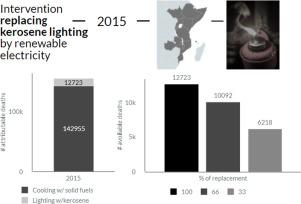Energy for Sustainable Development ( IF 4.4 ) Pub Date : 2021-05-25 , DOI: 10.1016/j.esd.2021.05.004 Natalia Ortega , Ariadna Curto , Asya Dimitrova , Jovito Nunes , Davide Rasella , Charfudin Sacoor , Cathryn Tonne

|
Background
Lighting sources have been overlooked in previous estimates of the health burden attributable to household air pollution (HAP). However, lighting sources can be an important predictor of personal exposure to HAP in countries with limited access to electricity. We modeled the health and environmental impacts of hypothetical intervention scenarios that replace kerosene-based lighting with renewable electricity in East Africa.
Methods
We used comparative risk assessment methods to quantify the ischemic heart disease-, stroke-, lung cancer-, chronic obstructive pulmonary disease- and lower respiratory infection-related morbidity and mortality attributable to personal fine particulate matter (PM2.5) exposure due to kerosene-based lighting for residents of East Africa in 2015. We used health and demographic data from the Global Burden of Disease; PM2.5 exposure estimates from a previous study replacing kerosene-based lighting with solar lighting; and exposure-response functions from the literature to estimate the number of deaths and DALYs that could be avoided with increased scaling-up of the lighting source intervention. We estimated avoided black carbon emissions using emission factors from published literature.
Results
We estimated that 6218, 10,092, 12,723 deaths and 409, 654, 814 hundred thousand DALYs could be avoided if 33%, 66%, and 100% respectively of households using kerosene-based lighting replaced it with electricity in East Africa in 2015. Including lighting fuel in estimates of deaths due to PM2.5 from household air pollution in the region would add a further 9% in addition to those from cooking with solid fuel. Full replacement of kerosene-based lighting with renewable electricity would have reduced black carbon emissions by 4.4 Gg/year or 3957 CO2eq Gg in 2015, with the largest emission reductions in Uganda and Kenya.
Conclusion
Kerosene-based lighting is a non-negligible source of HAP in the region and should be included in assessments of the health burden attributable to HAP.
中文翻译:

在东非用可再生能源电力取代煤油照明对健康和环境的影响
背景
以前的家庭空气污染(HAP)造成的健康负担估计中忽略了光源。但是,在电力有限的国家,光源可能是个人接触HAP的重要预测指标。我们对假设的干预情景对健康和环境的影响进行了建模,这些情景将在东非以可再生电力替代基于煤油的照明。
方法
我们使用了比较风险评估方法来量化由煤油引起的个人细颗粒物(PM 2.5)暴露所致的缺血性心脏病,中风,肺癌,慢性阻塞性肺疾病和下呼吸道感染相关的发病率和死亡率。在2015年为东非居民提供了照明。我们使用了全球疾病负担的健康和人口统计数据;一项先前研究的PM 2.5暴露估计值,用太阳能照明代替了基于煤油的照明;和文献中的曝光响应函数来估计死亡人数和DALYs的数量,这些死亡和DALYs可以通过扩大光源干预的规模来避免。我们使用已发表文献中的排放因子估算了避免的黑碳排放。
结果
我们估计,如果2015年东非地区分别使用煤油照明的33%,66%和100%的家庭用电取代了煤油,则可以避免6218、10092、12723死亡和409、654、814十万个DALY,包括2015年在内。除了使用固体燃料烹煮的食物外,估计该地区家庭空气污染造成的PM 2.5死亡人数将增加9%。用可再生电力完全替代基于煤油的照明将在2015年将黑碳排放量减少4.4 Gg /年或3957 CO 2当量Gg,在乌干达和肯尼亚的减少量最大。
结论
煤油照明是该地区HAP不可忽略的来源,应包括在对HAP造成的健康负担的评估中。











































 京公网安备 11010802027423号
京公网安备 11010802027423号